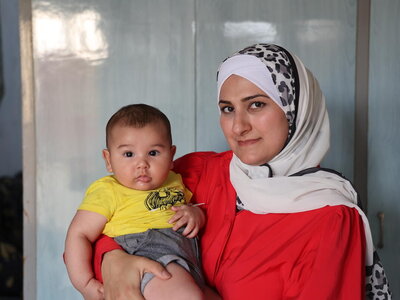Syrian Arab Republic
- 9.1 million
- people are food insecure
- 7.2 million
- people are internally displaced
- 3.6 million
- people supported by WFP in 2024
After 13 years of conflict and economic collapse, Syrians are finding it increasingly difficult to support their families. The country has the world’s second-highest number of internally displaced people.
The numbers are rising rapidly following the overthrow of the Government in late 2024 and the escalation of conflict in Lebanon.
A total of 9.1 million people are food insecure. Both maternal malnutrition and acute malnutrition in children under 5 are at global emergency thresholds.
The Syrian economy is collapsing. The cost of living has tripled in Syria over the past three years, with the minimum wage buying only a fifth of a family’s basic food needs and a tenth of essential needs.
Most people displaced from Lebanon are being hosted in communities which already had high levels of food insecurity, adding to the needs of the Syrian population.
The World Food Programme (WFP) had to reduce assistance by nearly 80 percent in 2024, due to funding shortfalls, and prioritize support to severely food-insecure people. We provide assistance to 1.5 million people each month but lack of funding hinders our ability to operate at scale.
We call on international partners to step up their support, so we can reach those most in need.
What the World Food Programme is doing in Syria
-
Emergency response
-
Since the situation in Syria escalated in late 2024, WFP and partners have provided ready-to-eat rations, as well as hot and fresh meals. Prior to this, an emergency response was activated within hours of the escalation of hostilities in Lebanon, to cope with an influx of people fleeing the war.
-
Food assistance
-
Due to funding shortfalls and higher food prices and operational costs, in 2023 WFP was forced to first reduce and then discontinue its large-scale General Food Assistance programme that had assisted 5.5 million people in Syria in 2023 alone. WFP launched a highly targeted emergency food assistance programme to reach 1 million severely food-insecure people. This is only a third of those severely food insecure in the country. School meals, nutrition and early-recovery work continue uninterrupted. However, dwindling humanitarian funding is limiting WFP’s ability to implement these activities at scale.
-
Nutrition
-
WFP’s nutrition programme helps children get the best possible start in life and supports pregnant and nursing mothers in fighting and preventing malnutrition. WFP currently supports over 300,000 pregnant and nursing women and girls, and children aged between 6 months and 2 years, to access nutrient-rich foods and improve their diets across all 14 governorates in Syria. This includes supporting women with value vouchers to diversify their diets, improve vitamin and mineral intake, and meet their nutritional needs.
-
School meals
-
WFP provides fortified snacks, fresh meals and food assistance, through electronic vouchers, to more than 460,000 students. This food is a key step in helping improve students’ health and nutrition, while motivating their families to keep sending them to school. The fresh school meals programme in Aleppo trains and employs vulnerable women to prepare the fresh meals, providing them with an income to support their families and become financially independent.
-
Livelihoods
-
To promote self-sufficient communities and reduce their reliance on urgent assistance, WFP helps families across Syria to restore their livelihoods, improve their food security and enhance their resilience to future shocks. Through vocational training and the rehabilitation of local infrastructure, such as irrigation channels and bakeries, Syrian families will have the opportunities to remain on their farms, grow their own food and improve their incomes.
Syrian Arab Republic news releases
Go to pageFind out more about the state of food security in Syrian Arab Republic
Visit the food security analysis pageOperations in Syrian Arab Republic
Contacts
Office
Mezzeh, Damascus, Syria
Damascus
Syria





